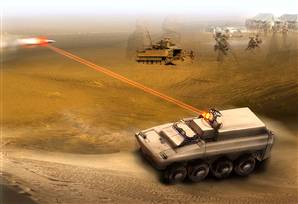 Tactical High Energy Laser
Tactical High Energy LaserTHEL laser n radar sys was designed to track up to sixty targets (mortar n artillery shells, rockets) at a time. Fire on n destroy these projectiles at a range of up to five km. THEL can destroy about a dozen targets a minute, at a cost of some $3,000US per shot. Each THEL sys (radar n laser) could cover about ten km of border.
Northrop Grumman now says that it can have an anti-rocket sys ready in 18 mths, at a development cost of $400 million. Each anti-rocket sys would cost about $50US million.
The Israeli Defense Ministry declined to elaborate on the test or the exact range of the intercepted missile. However, Pam Rogers, a U.S. Army spokeswoman in Huntsville, Ala., said the deuterium fluoride chemical laser destroyed an 11-foot-long, 6-inch-diameter (3.3-meter long, 15-centimeter-diameter) rocket.
In earlier tests the Nautilus laser had successfully eliminated 28 short-range Katyusha rockets and five artillery shells in flight as well as several “hostile objects” on the ground.
Northrop Grumman could deliver a mobile prototype by 2007 or 2008 if it gets a contract this summer, company spokesman Bob Bishop said from Redondo Beach, Calif. The project appears in the U.S. defense budget for fiscal 2004 with a $56 million allocation, he said.
 http://www.msnbc.msn.com/id/4926840
http://www.msnbc.msn.com/id/4926840 Skyguard Laser Air Defense System
Skyguard Laser Air Defense SystemNorthrop Grumman unveiled its Skyguard laser-based air defense system yesterday offering near-term defense against short-range ballistic missiles, short- and long-range rockets, artillery shells, mortars, unmanned aerial vehicles and cruise missiles. Derived from the Tactical High Energy Laser (THEL), one Skyguard system is capable of establishing a protective shield roughly 10 kilometres in diameter over an airport, military installation, small city or deployed forces.
Skyguard has higher power than heritage systems and a larger beam, making it a much more capable system, the company said.
The Bush administration is seeking to develop a powerful ground-based laser weapon that would use beams of concentrated light to destroy enemy satellites in orbit.
The largely secret project, parts of which have been made public through U.S. Air Force budget documents submitted to Congress in February, is part of a wide-ranging effort to develop space weapons, both defensive and offensive. No treaty or law forbids such work.
In 1997, the U.S. military fired a ground-based laser in New Mexico at a U.S. spacecraft, calling it a test of satellite vulnerability. Federal experts said recently that the laser had had no capability to do atmospheric compensation and that the test had failed to do any damage.
Little else happened until January 2001, when a commission led by Donald Rumsfeld, then the newly nominated defense secretary, warned that the U.S. military faced a potential Pearl Harbor in space and called for a defensive arsenal of space weapons.
The Starfire researchers are now investigating how to use guide stars and flexible mirrors in conjunction with powerful lasers that could flash their beams into space to knock out enemy satellites, according to federal officials and air force budget documents.
The research centers on Starfire's largest telescope. Its main mirror can gather in faint starlight or, working in the opposite direction, direct powerful beams of laser light skyward.
Air force budget documents call the telescope a "weapon-class beam director." Unclassified pictures of Starfire in action show a pencil-thin laser beam shooting up from its hilltop observatory into the night sky.
http://www.iht.com/articles/2006/05/03/news/space.php





